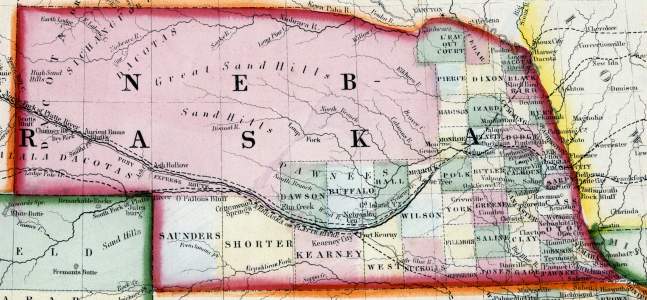Nebraska (Hayward)
NEBRASKA is the name by which an immense wilderness, lying among the north-western possessions of the United States, is now designated. It is bounded on the north by the British possessions; on the east by Minnesota Territory and the State of Iowa; on the south by the Indian Territory, (proper,) the State of Texas, and the Territory of New Mexico; and on the west by the Territory of Utah and Oregon Territory. The Missouri flows along its entire eastern frontier, and the Platte and Arkansas Rivers water its southern borders, while its western limits are formed by the Rocky Mountains. With a vast sweep from the north-west towards the central part of the country, and thence curving to the north, a portion of this lofty chain encloses, as it were, in an amphitheatre nearly one half of the whole region. It reaches from the 38th to the 49th degree of north latitude; its extreme south-eastern point lies in 95°, and its extreme north-western in 114° west longitude. It is between 600 and 700 miles in length, and from 400 to 500 miles in breadth, and contains an area of some 300,000 square miles.
All this broad expanse is yet to be subdivided, and gradually furnished with distinct forms of civil government, or remain as the barren heritage of the untamed races for whose behoof it seems naturally designed. At present, it is almost exclusively the abode of savages and wild beasts, and is traversed by civilized man only through the like necessity which impels him to cross the pathless ocean on his way to countries beyond. Its natural resources have never yet been developed, and little more is known of its topography, its waters, forests, plants, minerals, &c., than what has been gathered by dint of a few partial explorations, or by travellers in their hurried journeys towards Oregon and California.
From its geographical position it must be inferred that its soil, climate, natural products, and capacities for improvement do not differ essentially from those of the states and territories by which it is encompassed. But there are no authentic data from which may be compiled any satisfactory amount of statistical information in the premises.
Maps, exhibiting the outlines of its principal features, have from time to time been constructed and published, wherefrom the names and localities of the most prominent and striking objects — such as mountains, rivers, and lakes — may in some partial degree be ascertained. Reliable and accurate surveys are yet to be undertaken and accomplished by authority; until when the inquirer who would obtain exact details must be content with the meagre accounts of casual tourists, or the unauthenticated reports of adventurous visitors from the neighboring regions.
The manifold nations or independent tribes of aboriginal inhabitants sustain different relations to the people of the United States. Some of them, with whom treaties have been made, or negotiations held, are professedly friendly; while others are treacherously hostile, and almost irreclaimable. They are frequently at war with each other, and in all the arts of civilization are generally behind tlie Indians who reside farther south. The number of Indians occupying the country between the Mississippi and the Rocky Mountains may be estimated at not far from 250,000, including those who have emigrated from the eastern side of the Mississippi, and settled in the Indian Territory proper.
A view of the map of the country presents some striking lineaments, especially in the north-western quarter. The great basin, circumscribed as with a massive wall by the bold curvature of the Rocky Mountains, sends forth countless streams of varied extent, forming the sources of the Missouri River, and supplying the tract throughout with an abundance of watercourses, at remarkably regular distances. These streams are mostly dignified with names upon the maps; but whether their positions, dimensions, and tendencies are correctly delineated, is a question to be determined by future and more exact inspection. The southerly and easterly portions of the country are also amply furnished with those aquatic arteries and veins so necessary to the existence of a nation. The rivers already mentioned, as washing the eastern and southern boundaries, also receive innumerable branches; and there are some important streams which extend quite across from the very bases of the great mountain ridge on the west to the points of their junction with the Missouri, &c. Among the principal of these are the Platte, the Ni-obrarah, the Whiteearth, &c., with their numerous forks, all of which flow in an easterly direction.






